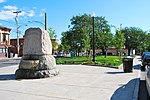James Hall Office

The James Hall Office, formerly a part of the Sunshine School, is a historic building located in Lincoln Park in the city of Albany, New York, United States. It is a small brick Italianate building now annexed to a more modern school building. In 1976 it was designated a National Historic Landmark for its association with James Hall (1811-1898), a leading American geologist of the 19th century.It is one of the few buildings remaining from a brief period of collaboration between Andrew Jackson Downing and Calvert Vaux. Hall, a paleontologist, led research on the geology of North America during the 19th century. He spent much of his time working in this small building, which served him as both office and laboratory. Among his many discoveries here, Hall found that the stromatolite fossils discovered at Petrified Sea Gardens, a site near Saratoga Springs, also a National Historic Landmark, were originally organic.In the late 20th century it was expanded slightly and annexed to one of Albany's elementary schools. It served that purpose until 2011. After voters approved the school district's plan to sell it, the building and annex is pending purchase by the Boys and Girls Club of Albany.
Excerpt from the Wikipedia article James Hall Office (License: CC BY-SA 3.0, Authors, Images).James Hall Office
Morton Avenue, City of Albany
Geographical coordinates (GPS) Address External links Nearby Places Show on map
Geographical coordinates (GPS)
| Latitude | Longitude |
|---|---|
| N 42.645833333333 ° | E -73.768611111111 ° |
Address
Sunshine School
Morton Avenue
12202 City of Albany
New York, United States
Open on Google Maps








